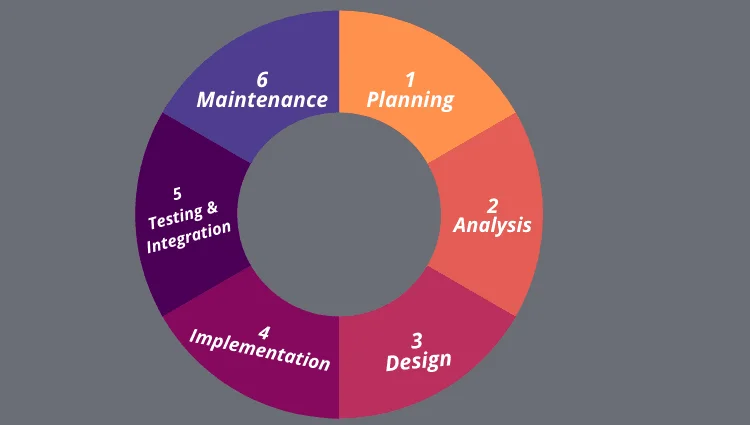The Importance of QA Testing Services in the Software Lifecycle
Software applications have become integral to business operations, communication, and daily life. The demand for high-quality, reliable software has never been greater, and users expect seamless experiences across all platforms. To meet these expectations, organizations must prioritize the quality of their software products.
This blog explores how QA testing services play a pivotal role in ensuring that software applications meet the highest standards of quality before they reach end-users. These services encompass a range of activities designed to identify defects, validate functionality, and ensure that the software performs as intended.
Understanding the Software Development Lifecycle (SDLC)
The Software Development Lifecycle (SDLC) is a structured approach to software development that outlines the stages involved in creating a software application. These stages typically include planning, design, development, testing, deployment, and maintenance. Each phase has its own set of objectives and deliverables, contributing to the overall success of the project.
QA testing is integrated into each stage of the SDLC to ensure that quality is maintained throughout the development process. By embedding QA practices early on, teams can identify and address issues promptly, reducing the risk of defects and ensuring that the final product meets the desired quality standards.
The Role of QA Testing in the SDLC
QA testing is an essential part of the Software Development Lifecycle (SDLC), ensuring that quality is maintained from start to finish. By incorporating testing at every stage, teams can identify and address issues early, leading to a more reliable and efficient product.
- Requirement Analysis
QA testing begins at the requirement analysis stage, where testers collaborate with stakeholders to understand the functional and non-functional requirements of the software. This early involvement ensures that the testing process aligns with the project’s objectives and user expectations. By reviewing requirements from a testing perspective, QA teams can identify potential ambiguities or inconsistencies that may lead to defects later in the development process.
- Test Planning
During the test planning phase, QA teams define the scope, strategy, resources, and schedule for testing activities. A well-structured test plan serves as a roadmap, guiding the testing process and ensuring that all aspects of the software are thoroughly evaluated. The test plan outlines the testing objectives, methodologies, tools, and deliverables, providing a clear framework for the testing efforts.
- Test Design
Test design involves creating detailed test cases and scenarios based on the requirements and design documents. These test cases are crafted to cover various use cases, including edge cases, to ensure comprehensive testing. By designing tests that mimic real-world scenarios, QA teams can identify potential issues that may not be apparent under normal conditions.
- Test Execution
In the test execution phase, QA teams run the test cases and document the results. Any defects or issues identified are reported to the development team for resolution. This phase is crucial for validating the functionality and performance of the software. By executing tests in different environments and configurations, QA teams can ensure that the software performs consistently across various platforms.
- Defect Tracking and Reporting
Effective defect tracking and reporting are essential for maintaining transparency and accountability. QA teams use defect tracking tools to log issues, monitor their resolution status, and communicate findings to stakeholders. By maintaining a detailed record of defects, teams can prioritize issues based on severity and impact, ensuring that critical problems are addressed promptly.
- Regression Testing
After defects are addressed, regression testing ensures that the fixes do not introduce new issues. This iterative process helps maintain the integrity of the software as it evolves. By re-running previously executed test cases, QA teams can verify that existing functionality remains unaffected by recent changes.
- Final Verification and Validation
Before deployment, QA teams conduct final verification and validation to confirm that the software meets all requirements and is ready for release. This final check is crucial for delivering a product that satisfies user expectations. By performing comprehensive testing, QA teams can ensure that the software is free from critical defects and is ready for production use.
Benefits of QA Testing Services
QA testing services offer significant advantages by ensuring early detection of defects, improving software quality, and enhancing user satisfaction. They also help organizations save costs by identifying issues before release, reducing the need for expensive post-launch fixes.
- Early Detection of Defects
By identifying defects early in the development process, QA testing services help prevent costly fixes later on. Early detection also reduces the risk of defects reaching production, where they can affect end-users. This proactive approach minimizes the impact of defects and ensures that the software meets quality standards.
- Enhanced User Satisfaction
Thorough QA testing ensures that software applications are user-friendly, reliable, and perform as expected. This leads to higher user satisfaction and positive feedback. By delivering a seamless user experience, organizations can build trust and loyalty among their customer base.
- Cost Efficiency
Investing in QA testing services can lead to significant cost savings by reducing the need for post-release fixes and minimizing downtime caused by defects. By addressing issues early, organizations can avoid expensive rework and maintain project timelines. This cost-effective approach contributes to the overall success of the project.
- Improved Brand Reputation
Consistently delivering high-quality software enhances a company’s reputation, fostering trust and loyalty among users and stakeholders. A strong brand reputation attracts new customers and retains existing ones, contributing to long-term business success. By prioritizing quality, organizations can differentiate themselves in a competitive market.
- Compliance and Security
QA testing services ensure that software applications comply with industry standards and regulations and are secure against potential threats. By adhering to compliance requirements, organizations can mitigate legal and financial risks. Security testing helps protect sensitive data and prevents unauthorized access, safeguarding both users and the organization.
Challenges in QA Testing
Despite its importance, QA testing faces several challenges, including evolving requirements, resource constraints, and complex software architectures. These obstacles can hinder the effectiveness of the testing process, requiring teams to adapt and find innovative solutions.
- Evolving Requirements
As project requirements change, maintaining the relevance of test cases can be challenging. QA teams must be agile and adapt test plans accordingly. Regular communication with stakeholders ensures that testing efforts align with the latest requirements. This adaptability is essential for successful QA testing.
- Resource Constraints
Limited resources can impact the depth and breadth of testing activities. Prioritizing testing efforts based on risk assessments can help mitigate this challenge. By focusing on critical areas, QA teams can maximize the effectiveness of their testing efforts. Efficient resource management ensures comprehensive testing within constraints.
- Complex Software Architectures
Modern software applications often have complex architectures, making testing more intricate. Utilizing advanced testing tools and techniques can aid in managing this complexity. Automated testing tools help streamline testing processes and improve coverage. Skilled QA teams can navigate complex systems to identify potential issues.
- Time Pressures
Tight deadlines can pressure QA teams to expedite testing processes. Implementing automated testing can help accelerate testing without compromising quality. Automation reduces manual effort and increases testing efficiency. Effective time management ensures thorough testing within limited timeframes.
The Future of QA Testing Services
As technology continues to evolve, the future of QA testing services will be shaped by innovations in automation, artificial intelligence, and machine learning. These advancements promise to make testing faster, more efficient, and capable of addressing complex challenges in real-time.
1. Automation
The adoption of automation in QA testing is increasing, allowing for faster and more consistent testing processes. Automated tests can be run frequently, providing quick feedback and supporting continuous integration practices. Automation enhances test coverage and reduces human error. It enables QA teams to focus on more complex testing scenarios.
2. Artificial Intelligence and Machine Learning
AI and ML are being integrated into QA testing to predict potential defects, optimize test cases, and enhance decision-making processes. These technologies can improve the efficiency and effectiveness of testing activities. AI-driven tools analyze historical data to identify patterns and anticipate issues. Machine learning algorithms adapt testing strategies based on evolving data.
3. Shift-Left Testing
Shift-left testing involves moving testing activities earlier in the development process, enabling early detection of defects and reducing the cost and effort of fixing them. This approach promotes a proactive quality culture within development teams. By integrating testing into the initial stages, organizations can identify issues before they escalate. Shift-left testing enhances collaboration between development and QA teams.
Conclusion
QA testing services are integral to the software development lifecycle, ensuring that applications meet quality standards and deliver value to users. By identifying and addressing defects early, QA testing enhances user satisfaction, reduces costs, and improves brand reputation. As technology evolves, the role of QA testing continues to expand, incorporating automation, AI, and continuous testing practices to meet the demands of modern software development.
Investing in robust QA testing services is not just a technical necessity but a strategic decision that can significantly impact the success of software products in the marketplace.







